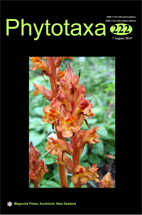Abstract
The fossil genus Naiadita Brodie (1845: 93) was originally described by Brodie based on a leafy plant species from the Late Triassic England, Naiadita lanceolata Brodie (1845: 93). The taxonomic position of the species has long fluctuated and it had been supposed to be a monocotyledon allied to Najas Linnaeus (1753: 1015), a water moss allied to Fontinalis Hedwig (1801: 298), or an aquatic Lycopod until Harris (1938, 1939) discovered its reproductive organs and made a comprehensive study on the species. On Harris’s (1938, 1939) closer examinations of the species, it turned out to be a liverwort allied to Riella Montagne (1852: 11) (Riellaceae, Sphaerocarpales, Marchantiopsida). However, its unusual combination of characteristics, makes it impossible to assign to an order/family of extant liverworts. Schuster (1953, 1966) proposed a monogeneric order Naiaditales and a family Naiaditaceae, placed in Marchantiidae of Marchantiopsida. These ordinal and family names are in common use in systematics of liverworts, (e.g. Grolle 1972; Schuster 1979; Krassilov & Schuster 1984; Schofield 1985; Brown 2003). However, each of these names lacked a description/diagnosis when proposed and has never been validly published (ICN Art. 38.1, McNeill et al. 2012). In order to be able to use these names, the ordinal and family names are validated here.

